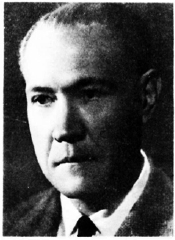- Volume 58 , Number 2
- Page: 396
Fernando Latapí, M.D. 1902-1989

Professor Dr. Fernando Latapí, one of the most distinguished dermatologists and a pillar of Mexican dermatology, died on 28 October 1989.
He was born in México City in October 1902, and studied at the University of Mexico, receiving his degree on 1 1 August 1928.
At the beginning, he dedicated his medical work to general practice but very soon he devoted himself to dermatology, training with Professor Salvador González Herrejón (in those days head of the dermatologic service of the General Hospital of México). Later, Latapí himself became the head of this service for a period of 25 years. He was also Director of Centro Dermatológico Pascua, the principal headquarters for the fight against leprosy in México, from 1937 to 1983.
He began his teaching career in 1937; he practically died teaching, because he never failed to give his classes.
He founded the Mexican Society of Dermatology in 1936, and the Mexican Association Against Leprosy in 1948; he was chairman of both societies. In 1960 he was appointed chief of the program against chronic skin diseases (leprosy), and he was honored with the Gaspar Viana Medal in 1960, the Eduardo Liceaga Medal in 1961, and the Damien-Dutton Award in 1978 for his important contributions in the field of leprosy.
He was President of the III Ibero-latino Congress of Dermatology in 1956, and of the XI International Congress of Leprosy held in México City in 1978.
His contributions in the fields of dermatology, leprology, and mycology are countless; herein are the most conspicuous: a) studies on Mai del Pinto; he described the early lesions -pintides. b) He rediscovered and studied the so-called Lucio's spotted leprosy which now bears his name " lepra de Lucio y Latapí." c) He contributed widely to changing the anachronic ideas about leprosy, lighting against prejudice and struggling all his life for a more humane behavior toward the leprosy patient, d) His contributions in the field of mycology were numerous: He used the depilatory treatment with thallium in tinea capitis; he was interested in deep mycoses, especially mycetoma; he used, for the first time, the sul-fones in the treatment of this disease, and griseofulvin in superficial and deep mycoses in Mexico, e) He was also interested in syphilis, tuberculosis, and cutaneous reactions such as caloric melanosis, the photosensibility of garlic, and the vitiligous lesions caused by the use of hydroquinone. f) He was an enthusiastic defender of psychosomatic dermatology and of an honest, human attention to the patients. He pointed out the damage produced by the numerous drugs used in actual therapy, and he coined the name " corticodermias," referring to all the damage produced in the skin by the immoderate use of corticosteroids.
He was a real professor, not only a teacher, because he not only taught a matter but always tried to modify attitudes, meaning, he educated; perhaps it was his most outstanding quality.
With his death, México and other Spanish-speaking countries have lost one of the most important dermatologists and human beings of this century.
- Amado Saúl,M.D.